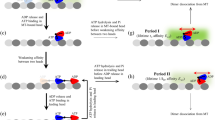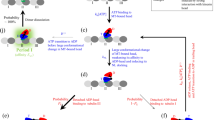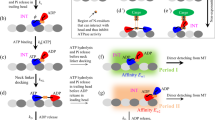Abstract
We use two-state ratchet models containing single and coupled Brownian motors to understand the role of motor-microtubule binding, ATPase reaction rate and dimerisation on the translational velocities of Kinesin motors. We use model parameters derived from the experimental measurements on KIF1A, KIF13A, KIF13B, and KIF16B motors to compute velocities in μm/s. We observe that both the models show the same trend in velocities (KIF1A > KIF13A > KIF13B > KIF16B) as the experimental results. However, the models significantly underpredict the velocities when compared with the experiments. The predictions of the coupled-motor model are closer to the experiments than those of the single-motor model. Our results indicate that the variation of ATPase reaction rate governs the trend in velocities for the above four motors. The variation of motor-microtubule binding affinity and the coupling strength between the motor domains may only have a secondary effect. More rigorous models that incorporate the power-stroke mechanism are necessary for better quantitative compliance with the experiments.




Similar content being viewed by others
Data availability
All data generated or analysed during this study are included in this published article.
References
Kolomeisky, A. B. (2015). Motor proteins and molecular motors. CRC Press, Boca Rato, FL.
Chowdhury, D. (2013). Stochastic mechano-chemical kinetics of molecular motors: a multidisciplinary enterprise from a physicist’s perspective. Physics Reports., 529(1), 1–197.
Goldstein, L. S. (2001). Kinesin molecular motors: transport pathways, receptors, and human disease. Proceedings of the National Academy of Sciences of the United States of America, 98(13), 6999–7003.
Guo, W., Stoklund Dittlau, K. & & Van Den Bosch, L. (2020). Axonal transport defects and neurodegeneration: molecular mechanisms and therapeutic implications. Seminars in Cell and Developmental Biology., 99, 133–150.
Misiura, M., Wang, Q., Cheung, M. S., & Kolomeisky, A. B. (2018). Theoretical investigations of the role of mutations in dynamics of Kinesin motor proteins. The Journal of Physical Chemistry B, 122, 4653–4661.
Gabrych, D. R., Lau, V. Z., Niwa, S., & Silverman, M. A. (2019). Going too far is the same as falling short†: Kinesin-3 family members in hereditary spastic paraplegia. Frontiers in Cellular Neuroscience 13, 419.
Hirokawa, N., Noda, Y., Tanaka, Y. & & Niwa, S. (2009). Kinesin superfamily motor proteins and intracellular transport. Nature Reviews Molecular Cell Biology, 10(10), 682–696.
Soppina, V. & & Verhey, K. J. (2014). The family-specific K-loop influences the microtubule on-rate but not the superprocessivity of kinesin-3 motors. Molecular Biology of the Cell, 25(14), 2161–2170.
Patel, N. M., Siva, M. S. A., Kumari, R., Shewale, D. J., Rai, A., Ritt, M., & Soppina, V. (2021). {KIF13A} motors are regulated by {Rab22A} to function as weak dimers inside the cell. Science Advances, 7(6), eabd2054.
Jülicher, F., Ajdari, A. & & Prost, J. (1997). Modeling molecular motors. Reviews of Modern Physics, 69(4), 1269–1282.
Ajdari, A. (1994). Force-free motion in an asymmetric environment: a simple model for structured objects. Journal of Physics. I France, 4, 1577–1582.
Derényi, I., & Vicsek, T. (1996). The kinesin walk: a dynamic model with elastically coupled heads. Proceedings of the National Academy of Sciences of the United States of America, 93(13), 6775–6779. https://doi.org/10.1073/pnas.93.13.6775.
Astumian, R. D., & Bier, M. (1994). Fluctuation driven ratchets: molecular motors. Physics Review Letters, 72(11), 1766–1769.
Liu, F., Ji, Q., Wang, H., & Wang, J. (2018). Mechanochemical model of the power stroke of the single-headed motor protein KIF1A. The Journal of Physical Chemistry B, 122(49), 11002–11013. https://doi.org/10.1021/ACS.JPCB.8B04433.
Hwang, W., & Karplus, M. (2019). Structural basis for power stroke vs. Brownian ratchet mechanisms of motor proteins. Proceedings of the National Academy of Sciences, 116(40), 19777–19785. https://doi.org/10.1073/PNAS.1818589116.
Wang, H.-Y., & Bao, J.-D. (2004). The roles of ratchet in transport of two coupled particles. Physica A: Statistical Mechanics and its Applications, 337(1), 13–26.
von, SG., M, E., & P, R. (2008). Dynamics of a dimer in a symmetric potential: ratchet effect generated by an internal degree of freedom. Physical Review. E, Statistical, nonlinear, and soft matter physics, 77(3 Pt 1). https://doi.org/10.1103/PHYSREVE.77.031136.
Kong, L.-W., Wan, R.-Z., & Fang, H.-P. (2016). Transportation of two coupled particles in an asymmetric saw-tooth potential. Chinese Physics Letters, 33(2). https://doi.org/10.1088/0256-307X/33/2/020501.
Mandelkow, E., & Johnson, K. A. (1998). The structural and mechanochemical cycle of kinesin. Trends in Biochemical Science, 23(11), 429–433.
Guo, S.-K., Shi, X.-X., Wang, P.-Y., & Xie, P. (2018). Processivity of dimeric kinesin-1 molecular motors. FEBS Open Bio, 8(8), 1332–1351.
Guo, S.-K., Wang, P.-Y. & & Xie, P. (2017). A model of processive movement of dimeric kinesin. Journal of Theoretical Biology, 414, 62–75.
Soppina, V., Norris, S. R., Dizaji, A. S., Kortus, M., Veatch, S., Peckham, M. & & Verhey, K. J. (2014). Dimerization of mammalian kinesin-3 motors results in superprocessive motion. Proceedings of the National Academy of Sciences of the United States of America, 111(15), 5562–5567.
Soppina P, Patel NM, Shewale DJ, Rai A, Sivaramakrishnan S, Naik PK & Soppina V (2021). Kinesin-3 motors are fine-tuned at the molecular level to endow distinct mechanical outputs (Under review).
Rousselet, J., Salome, L., Ajdari, A., & Prost, J. (1994). Directional motion of Brownian particles induced by a periodic asymmetric potential. Nature, 370(6489), 446–448.
Wang, H., Peskin, C. S., & Elston, T. C. (2003). A robust numerical algorithm for studying biomolecular transport processes. Journal of Theoretical Biology, 221(4), 491–511.
Dan, D., Jayannavar, A. M., & Menon, G. I. (2003). A biologically inspired ratchet model of two coupled Brownian motors. Physica A: Statistical Mechanics and its Applications, 318(1), 40–47.
Grimm, A., Stark, H. & & van der Maarel, J. R. C. (2009). Model for a Brownian ratchet with improved characteristics for particle separation. Physical Review. E, Statistical, Nonlinear, and Soft Matter Physics, 79(6 Pt 1), 61102
Amos, L. A., & Hirose, K. (2007). A cool look at the structural changes in kinesin motor domains. Journal of Cellular Science, 120(Pt 22), 3919–3927.
Xie, P., Dou, S.-X., & Wang, P.-Y. (2007). Processivity of single-headed kinesin motors. Biochimica Biophysics Acta, 1767(12), 1418–1427.
Lipowsky, R. (2001). Movements of molecular motors. Biological Physics 2000, World Scientific Publishing Company, Singapore.
Retkute, R., & Gleeson, J. P. (2005). Interaction of coupled particles based on Lennard-Jones and spring forces in Brownian Ratchet devices. NSTI-Nanotech 2005, 1, 540–543.
Acknowledgements
V.S. acknowledges funding through DBT (Grant No.: BT/PR15214/BRB/10/1449/2015 and BT/RLF/Re-entry/45/2015) and DST-SERB (Grant No.: ECR/2016/000913). P.S. acknowledges funding from DST (Grant No.: SR/WOS-A/LS-73/2017). N.M.P. acknowledges fellowship from IIT Gandhinagar. K.R. acknowledges funding from DST-SERB (Grant No.: ECR/2016/001220). R.M. acknowledges funding from MHRD and IIT Gandhinagar.
Author information
Authors and Affiliations
Corresponding author
Ethics declarations
Conflict of Interest
The authors declare no competing interests.
Additional information
Publisher’s note Springer Nature remains neutral with regard to jurisdictional claims in published maps and institutional affiliations.
Rights and permissions
About this article
Cite this article
Mukherjee, R., Soppina, P., Patel, N.M. et al. Effect of Binding-Affinity and ATPase Activity on the Velocities of Kinesins Using Ratchet Models. Cell Biochem Biophys 80, 31–38 (2022). https://doi.org/10.1007/s12013-021-01057-x
Received:
Accepted:
Published:
Issue Date:
DOI: https://doi.org/10.1007/s12013-021-01057-x




